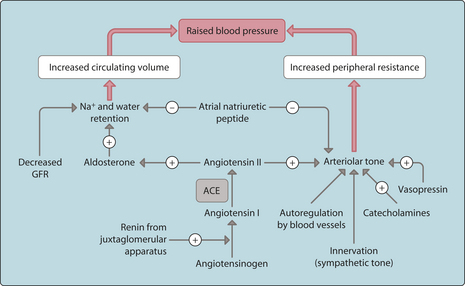Chapter 41 Hypertension and hypertensive heart disease
Vascular changes in hypertension
Hyaline arteriolosclerosis. This is an ageing-related change common in elderly individuals. However, it appears earlier in patients with either hypertension or diabetes. It is characterized by hyaline thickening of the walls of arterioles, with some luminal narrowing. It is believed to be caused by leakage of plasma proteins into the wall and increased production of extracellular matrix by smooth muscle cells in response to raised blood pressure.
Hyperplastic arteriolosclerosis. This condition is seen in more severe hypertension, including malignant hypertension. It is characterized by proliferation of smooth muscle cells and basement membrane material, causing concentric laminations. The result is progressive, severe narrowing of the lumen.
Regulation of normal blood pressure
Blood pressure is a function of cardiac output and peripheral resistance. Cardiac output is affected by the intravascular volume, while the peripheral resistance is controlled principally by arteriolar tone (Fig. 3.41.1).
< div class='tao-gold-member'>
Only gold members can continue reading. Log In or Register to continue
Stay updated, free articles. Join our Telegram channel

Full access? Get Clinical Tree








